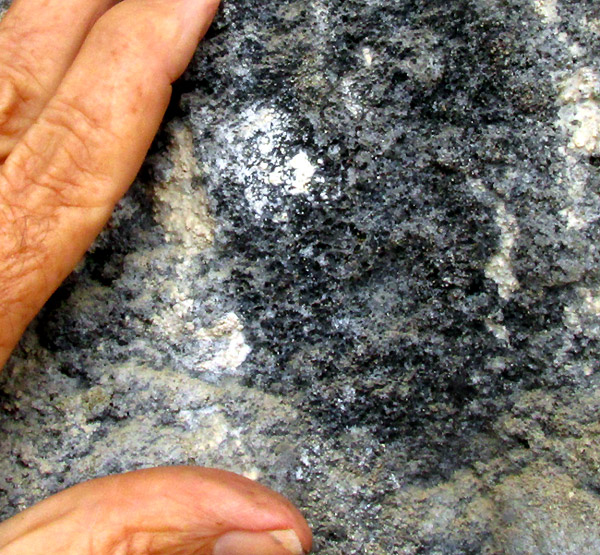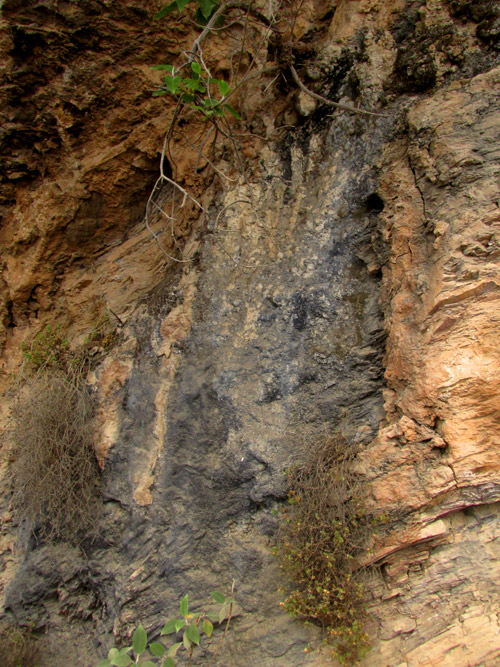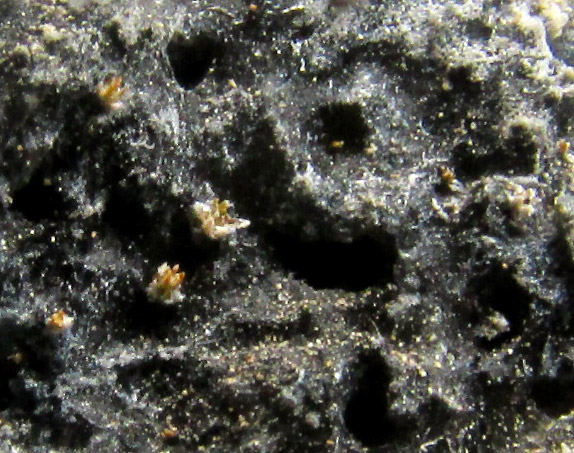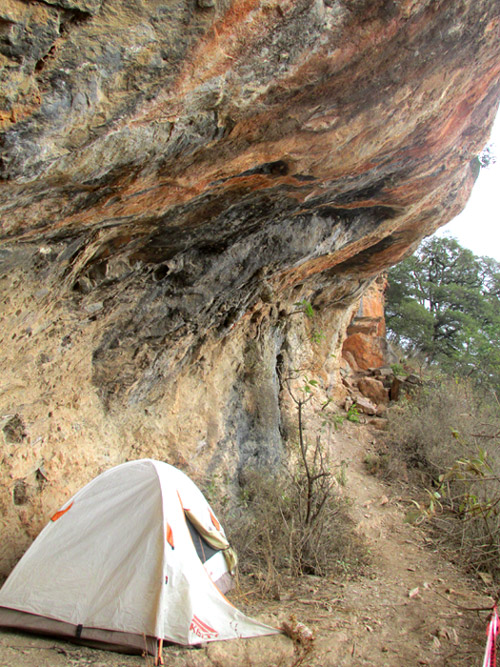Excerpts from Jim Conrad's
Naturalist Newsletter
Entry from field notes dated June 30, 2023, taken along small gravel road about 1 km west, across valley, of El Suspiro about 1 straight-line km NW of El Doctor; in the mountains of east-central Querétaro state, municipality of Cadereyta de Montes, 12 straight-line kms due east of Vizarrón de Montes but much farther by twisting roads; elevation ~2600m (~8500 ft), Querétaro, MÉXICO, (N20.85563°, W99.58686°)
LICEA cf. BELMONTIANA

A geological fault cut down through a massive limestone rockshelter. Restricted to the shelter's back wall immediately around the fault, a kind of purplish-black, blotchy, gelatin-like film covered the rock surface, a small part of which is shown above. Below, you can see how layers of limestone on each side of the fault shattered where the opposing rock surfaces slipped against one another:

When the purplish-black surface was examined with a hand lens, this was discovered:

Amid expanses of a pitted, gently rolling, purplish-black, glossy surface, a few structures looking very much like tiny flowers appeared. However, no flowering plant produces such small blossoms. The smallest blossoms are produced by watermeal, with flowers about 0.3mm in width. My very rough estimate was that these flower-like structures were about 0.1mm across.
Because the purplish-black surface was like a thin layer of gelatin, it seemed we might have a slime mold here. Slime molds constitute a whole other, weird and profoundly diverse world of living things, as Wikipedia's Slime Mold page suggests. We've met a few of them such as the one on piles of horse manure just outside Tepotzlán south of Mexico City. That one grew an abundance of spore-producing fruiting bodies, or sporocarps, unlike anything seen on our overhang's back wall. However, in the Yucatan we had a very different one which appeared to be developing sporocarps that were somewhat flower-like (third picture from top), though those much larger than ours.
The Internet provides many pictures of amazing slime molds, often displaying a rainbow of sporocarp forms. Eventually I found images of sporocarps looking very much like ours, in a 2012 study by Martin Schnittler and others entitled "Fruit body-forming protists: Myxomycetes and Myxomycete-like organisms Acrasia, Eumycetozoa." It identified the taxon bearing the similar sporocarps as LICEA BELMONTIANA.
A closely related species also was illustrated, Licea pygmaea, but, at least in the pictures, the petal-like sections of Licea pygmaea, the platelets, were not white-margined like ours, nor were they so sharp-pointed at their tips. Both species are more likely to be reported in Europe and North America, though both also occur here and there worldwide, and Licea belmontiana has been observed in Mexico.
I'm filing this page on the Internet under Licea cf. belmontiana, with the "cf." being an accepted way to say "I'm unsure this is right, but I hope someone will confirm or challenge the ID." I'm unsure because the only technical description of Licea belontiana I can find says that the species inhabits the bark of living trees. Also, identifying by pictures is a shaky way of doing it, plus I'm unsure whether with slime molds anyone can be certain without microscopic and/or genetic analysis.
In the above close-up of the flower-like sporocarps, it appears that inside the spreading, petal-like platelets there's something looking spookily like stamens and ovary. That's the spore-mass detaching from the apple-core-like center structure, the columella. The sporocarps are opening to release their spores.
Beneath the rock overhang, why should this slime mold be restricted to a fault zone? Maybe it's because water passes downward through fractured rock caused by the fault more easily than through layers of solid rock. It's also true that only about 10 meters away an igneous intrusion of basalt cut through the limestone layers, plus in the rockshelter's general area there were silver mines; unusual mineral accumulations occur in the area, which conceivably could attract the species.
Here's a view of the rock overhang, on the sheltered back wall of which the slime mold found a home:
